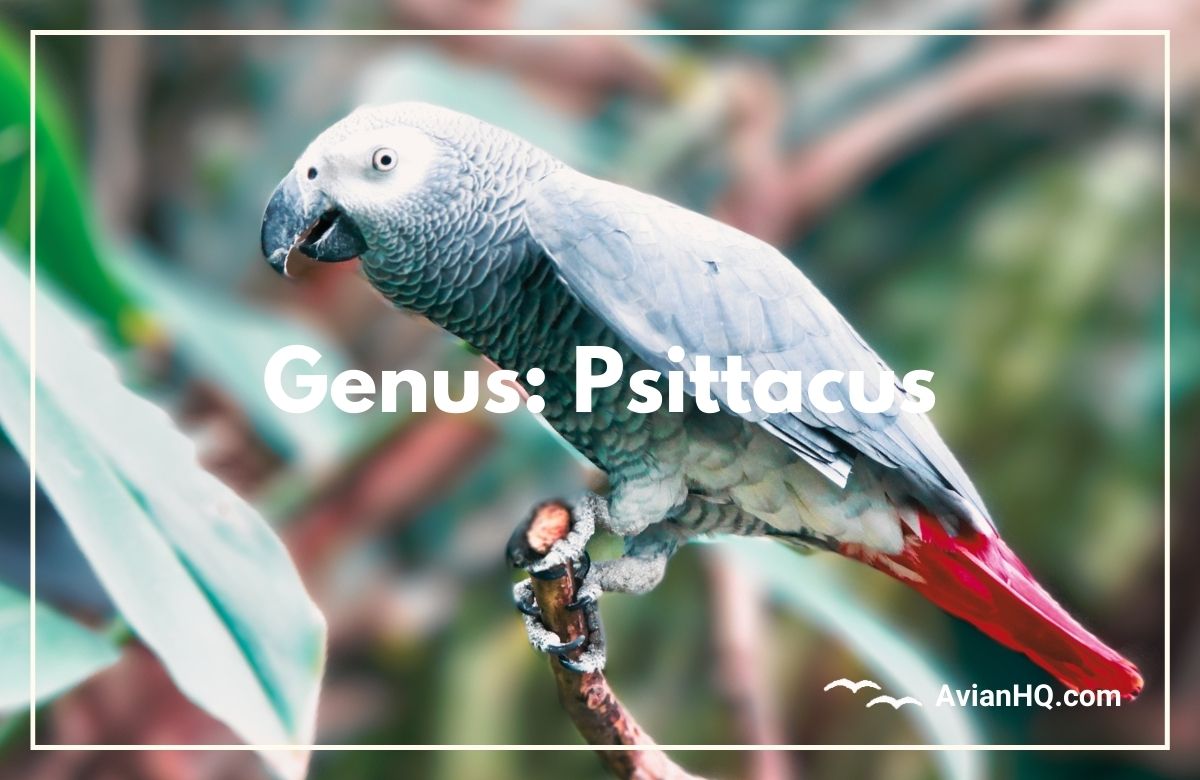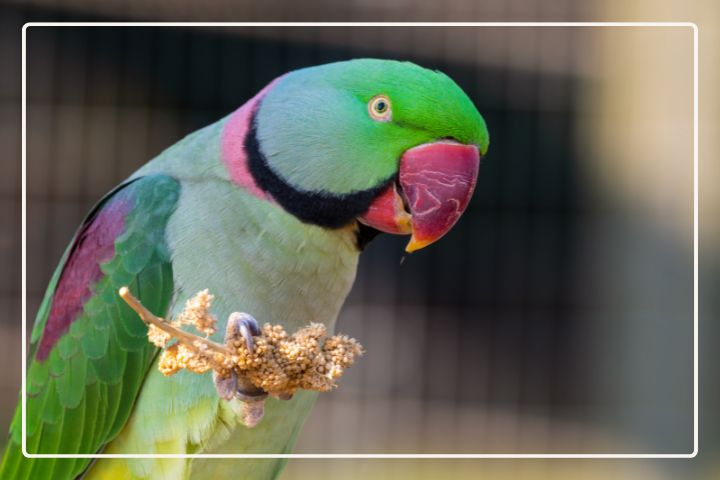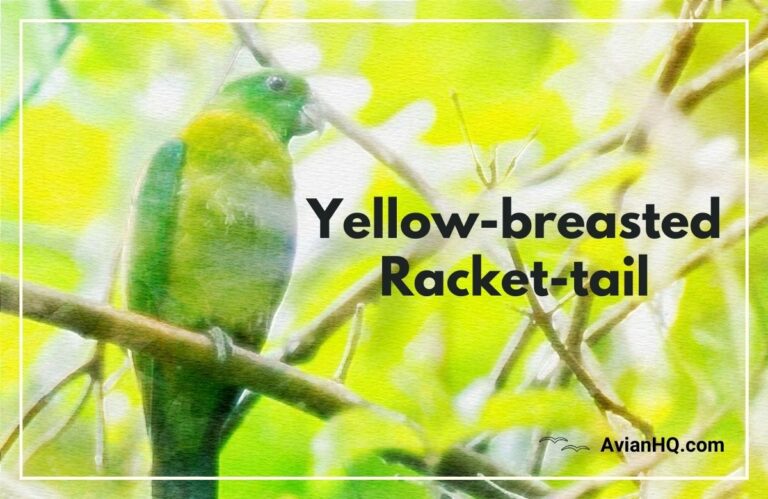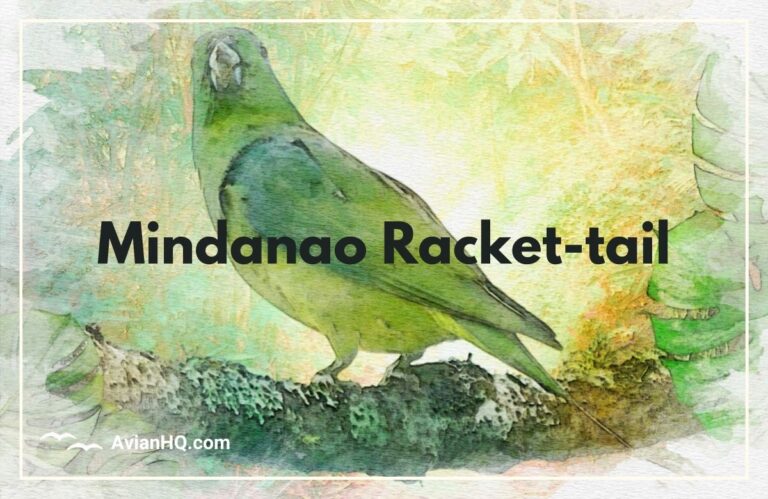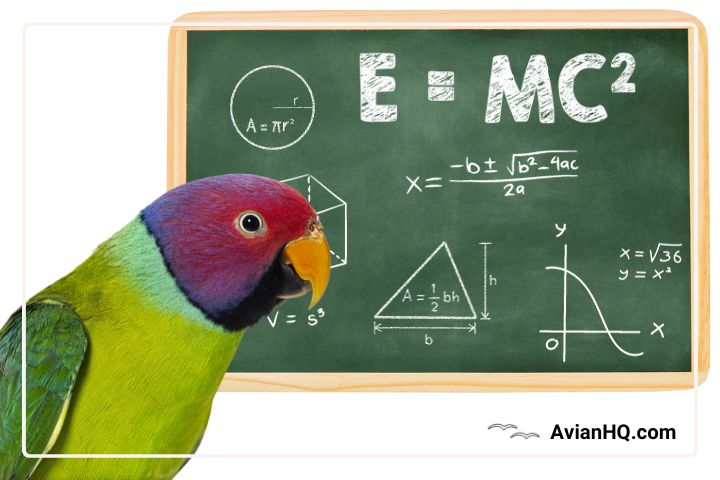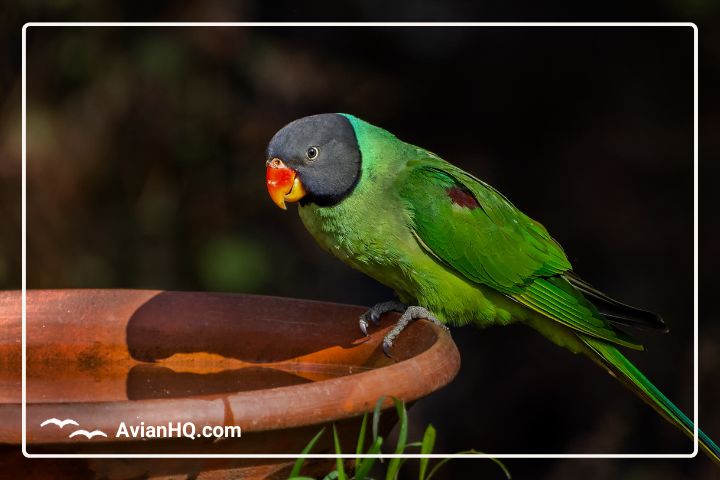Genus: Psittacus
Have you ever seen a clever grey parrot talking away or whistling a tune? Chances are it was one of the two species in the genus Psittacus – the iconic African grey parrots. These intelligent birds have captured our imaginations with their ability to mimic human speech and solve problems.
“Grey parrots possess cognitive abilities rivalling dolphins, chimpanzees, and human toddlers.”
The genus Psittacus contains just two members:
- The Grey Parrot (Psittacus erithacus), larger with light grey feathers and a bright red tail
- The Timneh parrot (Psittacus timneh), slightly smaller with darker charcoal grey plumage and a darker maroon tail
Both species are endemic to the rainforests of West and Central Africa and face threats from habitat loss and trapping for the pet trade. In the wild, these parrots live in large flocks, nest in tree cavities, and feed on nuts, seeds, fruits and vegetation. Their high level of intelligence likely evolved to help them survive and thrive in complex forest environments.
In captivity, grey parrots like those in genus Psittacus can make engaging companion birds. However, prospective owners should understand their complex social and behavioral needs. When properly cared for, these parrots may learn hundreds of words and sounds, use them correctly in context, and live for 40-60 years.
In this blog, we will spotlight key facts about the two Psittacus species, explore what makes them so smart, discuss their significance to humans, and outline conservation efforts critical to their future. Let’s take a closer look at these fascinating birds!
Species Spotlights
The genus Psittacus contains two closely related yet distinct species of African grey parrots. Let’s learn more about their key traits and habitats.
Grey Parrot (Psittacus erithacus)
- Size: 33 cm (13 in) long with a wingspan around 46-52 cm (18-20 in)
- Coloration: Light grey feathers, bright red tail, black beak, pale yellow irises in adults
- Range: Southern Ivory Coast to Kenya and down through Angola
- Habitat: Lowland rainforests, prefers tall mature trees up to around 60 m (200 ft) tall
The grey parrot, also called the Congo African grey parrot, is the more common of the two Psittacus species. It prefers primary forests but also inhabits forest edges and clearings. This social bird travels in noisy flocks of 10 to 30 individuals while foraging for fruit, nuts, and seeds.
Nesting takes place in tree cavities with clutches of 3-5 eggs. The altricial chicks rely on their parents for care and fledge at 12 weeks old.
Timneh Parrot (Psittacus timneh)
- Size: 22–28 cm (9-11 in) long
- Coloration: Dark charcoal grey, darker maroon tail, light upper mandible
- Range: Guinea-Bissau to western Ivory Coast
- Habitat: Humid lowland forests
Slightly smaller than it’s relative, the Timneh parrot favors forests below 1200 m (4000 ft) in elevation. It’s range lies completely separate from that of the grey parrot’s, separated by the Bandama river in Ivory Coast.
Timneh parrots assemble in large, noisy flocks that travel together between roosting and feeding areas. They prefer to nest in the old woodpecker holes of mature trees.
Behavior and Intelligence
The African grey parrots of genus Psittacus display some remarkably smart behaviors, especially when it comes to communication, social interactions, and problem-solving.
Social Behavior
Grey parrots are highly social and communicative birds. In the wild, they live in large flocks of 10 to 30 birds. Different calls are used to keep the flock together, signal about feeding areas and roosts sites, raise alarms about predators, and maintain social bonds.
Breeding pairs seperate from the main flock during mating season. However, both parents work together to incubate the eggs and feed the demanding chicks in their tree hollow nest.
Timneh parrots exhibit similar social behaviors, gathering in loud, gregarious flocks that coordinate their daily activities through various vocalizations.
“In captivity, grey parrots like those in genus Psittacus can make engaging companion birds. However, prospective owners should understand their complex social and behavioral needs.”
Intelligence and Cognition
Among birds, parrots have evolved large brains relative to their body size and display many complex cognitive abilities. The African greys of genus Psittacus are particularly celebrated for their intelligence.
In controlled experiments, grey parrots demonstrate the ability to:
- Associate words and sounds with objects, correctly using words like “corn” when shown corn kernels
- Categorize objects based on traits like color, shape, or material
- Infer relationships between objects, understanding which items go together
- Grasp concepts like relative size, absence, zero, and order
- Count quantities up to and beyond the number six
Research by Dr. Irene Pepperberg with a grey parrot named Alex revealed his ability to learn over 100 words, intelligently apply and combine concepts, count small sets of items, and express desires and intentions.
What’s more, grey parrots have shown an aptitude for:
- Social learning by observing other parrots
- Using tools to solve problems, like pulling strings or standing on perches to access rewards
- Coordinating their actions with other birds to achieve a common goal
So why did these African parrots evolve such high intelligence compared to many other birds? Their large brains likely help them adapt and survive within the complex forest ecosystem where they live. Navigating their habitat, locating nutritious foods, communicating across a flock, and outwitting predators all demand substantial mental skills.
In captivity, the advanced cognitive abilities of genus Psittacus allow them to learn impressive vocabularies and develop strong social bonds with their human caretakers. However, their intelligence also requires lots of mental stimulation and interaction to prevent boredom and behavioral issues.
Cultural Significance
The genus Psittacus has captivated humans for centuries with their beauty, longevity, and intelligence. Grey parrots likely influenced our understanding of animal minds while their popularity as pets persists today. However, concerns over unsustainable trade and habitat loss now threaten these birds.
History as Pets
There is a long history of grey parrots being kept as pets including:
- Ancient Greeks and Romans valuing the birds for their ability to mimic speech
- 16th century Portuguese sailors returning with grey parrots from West Africa
- Wealthy families in Medieval England and Europe keeping parrots as status symbols
- King Henry VIII reportedly owning an African grey parrot
In more recent times, the surge of Europe’s colonial expansion exposed many wealthy individuals to exotic African parrots. And tales of remarkably clever pet greys learning scores of words and phrases have continued to captivate the public over the last century.
Scientific Insights
Studies of the cognitive and social abilities of genus Psittacus have challenged assumptions about avian intelligence. Grey parrots can learn faster and use language more meaningfully than almost any other birds.
“Irene Pepperberg’s groundbreaking research with Alex the grey parrot proved his ability to intelligently apply concepts, reason about relationships between items, express intentions, and grasp the meanings of words.”
Observing grey parrots taught scientists that birds possess many “human-like” modes of communication, social bonding, and problem solving. This work has shaped our understanding of animal minds and the evolution of intelligence.
Conservation Concerns
Parrot enthusiasts must balance their admiration for genus Psittacus members with sustainability. The African grey parrot trade removed up to 21% of the wild population per year in the 1990s and 2000s.
Both species now face threats from:
- Habitat loss as African rainforests are logged
- Over-collection for the global pet market
- Climate disruptions to their forest ecosystem
Increased legal protections aim to alleviate these issues. The wild capture and export of greys is now restricted. However, saving their remaining habitats remains critical for conservation.
Threats and Conservation
While the members of genus Psittacus show remarkable intelligence and adaptability, loss of habitat and trapping pressures have caused significant population declines. However, increased legal protections provide hope for stabilizing vulnerable African grey parrot numbers.
Key Threats
The major hazards facing grey and Timneh parrots stem from humans:
- Deforestation: Logging, clearing for agriculture, and development shrinks rainforest habitat
- Trapping for trade: An estimated 600,000+ wild greys were exported in the past 20 years
- Climate impacts: Global warming and extreme weather events degrade forests
As natural old-growth nesting and foraging grounds diminish, wild flocks struggle to find adequate food, shelter, and breeding sites. Compounding this habitat loss is the large scale removal of parrots to supply persistent market demand.
Conservation Actions
Several regulations now restrict parrot trade and promote better captive breeding practices including:
- CITES protections: Export permits required, some trade bans instituted
- Import/export laws: Wild capture import prohibited by EU, USA, others
- Aviculture management: Encouraging conservation-focused breeding programs
Critically, the preservation of primary rainforests is also vital for securing Psittacus populations that rely so extensively on large old trees and nutritious forest resources.
While far from certain, a combination of smart protective policies, responsible aviculture, and forest ecosystem protections provide hope for the future of these cherished birds.
Conclusion
The genus Psittacus contains two remarkable species – the Grey parrot and the Timneh parrot. As some of the most intelligent birds on Earth, these African parrots continue to fascinate avian researchers and pet owners alike.
In revisiting key details about these species, we’ve explored:
- Their shared traits like advanced cognitive abilities, loud flocking behavior, forest-dwelling lifestyle, and need for large nesting trees
- The threats they face from deforestation, climate change, and trapping for the global pet trade
- Conservation actions like legal protections, responsible captive breeding, and rainforest preservation that can ensure their future
While human encroachment has led to declining populations, genus Psittacus possesses the evolutionary intelligence and adaptability to recover if given the chance. Their ability to mimic speech seems symbolic of an innate desire to communicate with and perhaps guide humanity towards sustainable coexistence.
If protected rainforest habitats remain where evolution molded their superior brains, flocks of African greys and Timnehs may grace the canopies for millennia to come. Their preservation is central not only to avian biodiversity – but also to understanding the nature of intelligence itself.

